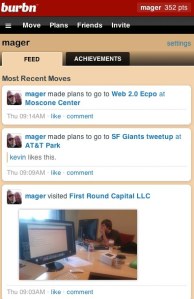Even now, it’s still shocking how the remarkably low distribution costs of the web can change a founder’s fate overnight. Many startups are duds, and most grow at a clip that’s just not fast enough to justify an interesting valuation.
But once in awhile, a company comes along and just nails it. The right timing. The right market. The right place. Then all the rules you know about multiples, comparable benchmarks and so on just buckle under the pressure of momentum.
I met Instagram’s co-founders Kevin Systrom and Mike Krieger before they were working together. Mike, or “Mikey,” is one of the sweetest, most self-effacing engineers and user experience designers I know. At the time, he was toiling away at Meebo. He would test their interface with groups of high school students he brought into the company’s Mountain View office. Funnily enough, while in university, he actually worked on a photo-sharing project for a class. It was a featurephone-era app for treating seasonal affective disorder and it was called something like, “Send Me Some Sunshine.” The idea was that one user on one side of the world would send a photo of sunshine to another in a wintery climate with fewer hours of daylight just to cheer them up.
Systrom, meanwhile, had just come off of a year at Nextstop, a travel-oriented startup that had sold to Facebook in a talent acquisition. He had also spent a year in Google’s corporate development department (read: the department that does M&A). But after interning at the company that would become Twitter, he always had the itch to do something on his own.
In early 2010, Systrom was messing around with a few ideas. Back then, location was hot, hot, hot. Foursquare had launched about a year earlier and had made the check-in a cultural phenomenon. It made sense to experiment with location. Perhaps an HTML5-based check-in app was the way to go.
 So Systrom, ever the connoisseur of fine whiskeys, tested an app called Burbn. It was very basic. It had about four tabs. You could “Move” or check in somewhere new. You could also post your plans, echoing Plancast, a service built by a TechCrunch alum Mark Hendrickson. But from a user experience perspective, it was a little rickety. HTML5 has latency issues (as you might be able to tell from Facebook’s current mobile apps, which are largely written in HTML5).
So Systrom, ever the connoisseur of fine whiskeys, tested an app called Burbn. It was very basic. It had about four tabs. You could “Move” or check in somewhere new. You could also post your plans, echoing Plancast, a service built by a TechCrunch alum Mark Hendrickson. But from a user experience perspective, it was a little rickety. HTML5 has latency issues (as you might be able to tell from Facebook’s current mobile apps, which are largely written in HTML5).
Users weren’t exactly checking in all the time on Burbn. Instead, we were sharing photos. Latte photos. Dog photos. Beer photos. Photos of our reflection in the bathroom mirror taken with an iPhone. Just mundane photos of everyday life.
It was around this time that Krieger, who was ready for change after a year and a half at Meebo, came on board. He ended up being a fantastic complement to Systrom, who had honed his programming skills while building Burbn. Krieger joined Systrom in Dogpatch Labs when it was still at San Francisco’s Pier 38.
 The pair looked at how users in Burbn’s beta gravitated toward photo-sharing and then studied every single popular app in the photography category.
The pair looked at how users in Burbn’s beta gravitated toward photo-sharing and then studied every single popular app in the photography category.
They scrapped Burbn and started over. It seems obvious in retrospect, but it wasn’t clear at the time that this the was right move. The photography category seemed saturated, but Systrom saw an opening that many others didn’t. Hipstamatic was super-fun and came packaged with all of these filters, but it wasn’t very social. Systrom thought there was a sweet spot in between Hipstamatic and Facebook, and that’s precisely where Instagram landed.
It took several months of prototyping and experimentation. There was a precursor to Instagram called Scotch, but it didn’t have filters and it was slow and buggy. Yet the concept of photo-sharing kept calling out to them.
With their UX skills, Krieger and Systrom refined Instagram to require as few actions as possible. Unlike the original version of Path, Instagram didn’t force users to add tags about people or places to their photos. A photo could be posted in as few as three clicks. Mirroring Twitter, they made Instagram public by default.
After months of testing, Instagram launched on Oct. 06, 2010. Systrom and Krieger didn’t know exactly what to expect, but 25,000 users showed up on the first day. For late 2010 when there were fewer iPhones on the market, that was a big number. The traffic was so overwhelming that they didn’t get home until 6 a.m. the next day.
 After that, it was just a whirlwind ride. Instagram had nailed the timing. The iPhone 4 was just arriving and its camera was finally good enough to cannibalize point-and-shoot cameras. Apple also had an installed base of iOS devices that was now large enough to produce the network effects that Instagram needed to take off.
After that, it was just a whirlwind ride. Instagram had nailed the timing. The iPhone 4 was just arriving and its camera was finally good enough to cannibalize point-and-shoot cameras. Apple also had an installed base of iOS devices that was now large enough to produce the network effects that Instagram needed to take off.
Instagram hit one million users in three months. Then that became two million, which then became 10 million users. Unlike many apps at the top of the charts, Instagram didn’t have to spend a dime to get where it was. It was organic growth.
Krieger had to carry around his laptop everywhere and be ready to whip it out at a moment’s notice in case the site crumbled under the server load. (He often did this. In the middle of dinner. In a bar. Everywhere and thankfully so, since there was never any Instagram version of Twitter’s infamous “Fail Whale.”)
Every month seemed more unreal. When Justin Bieber joined, there was literally a visible spike in activity as thousands of girls responded to his every photo. Then there was the time that Bieber’s agent called up Systrom demanding that the pop star be compensated for using Instagram. As the story goes, Systrom said no and Bieber ended up using it anyway.
 Kevin and Mikey weirdly became celebrities in their own right. Krieger met Michelle Obama at the State of the Union. Systrom met U.K. Prime Minister David Cameron and hung out with Jamie Oliver. They appeared on magazine covers.
Kevin and Mikey weirdly became celebrities in their own right. Krieger met Michelle Obama at the State of the Union. Systrom met U.K. Prime Minister David Cameron and hung out with Jamie Oliver. They appeared on magazine covers.
All the while, Systrom kept saying he never felt threatened by Facebook. Facebook’s mobile apps were just too complicated. The iOS app just had too many things in it. To please the company’s more than 850 million monthly active users, Facebook had to stuff every bell and whistle of the desktop site into its mobile app. That just wasn’t conducive to a great user experience on a phone.
In contrast, Instagram kept its app lean. They didn’t change much to the app’s essential experience even as its user base ballooned. It was more important to say ‘No’ to new features instead of ‘Yes.’ When Instagram took funding from Benchmark Capital, their new board member Matt Cohler, who came from Facebook, encouraged them to focus on growth first and worry about the revenue model later.
Indeed, when you have a consumer-facing app that is going to be advertising dependent, scale matters most. If you don’t have the eyeballs, you don’t get the advertising dollars.
 Instagram had grown so fast that Systrom appeared on-stage last month at SXSW to announce that the app had 27 million registered users. That was nearly twice the size of Foursquare and the app was still only on one platform. If you consider that Apple has said it has sold a cumulative 315 million iOS devices to date, that implies that Instagram is probably on more than 10 percent of all active iPhones.
Instagram had grown so fast that Systrom appeared on-stage last month at SXSW to announce that the app had 27 million registered users. That was nearly twice the size of Foursquare and the app was still only on one platform. If you consider that Apple has said it has sold a cumulative 315 million iOS devices to date, that implies that Instagram is probably on more than 10 percent of all active iPhones.
Systrom made a veiled threat to Facebook on-stage last month at SXSW. He said he thought of Instagram as more of a social network than a photo-sharing app.
He said, “It’s Facebook-level engagement that we’re seeing.”
Last week when Instagram launched on Android, it racked up more than 1 million users in 24 hours. In the blink of an eye, Instagram may have ended up with 50 million users. With Android and iOS adding more devices per month than Facebook is adding users, there was a threat that a brand new social network could spring up right under Facebook’s nose.
The rationale for the deal makes sense. As for the price? You can debate all you want about the price, considering that Instagram was still pre-revenue and had about a dozen employees. Whatever price it went for at this stage, it was going to be controversial. And Instagram was going to be worth whatever Mark Zuckerberg felt like paying for it. That is the definition of “worth” — it’s whatever the market will bear. We can talk about the Bubble-nomics in another post.
In the end, it’s been a truly wild ride for the pair. Congrats, guys. You’re damn lucky, but you earned it too.
































Comment